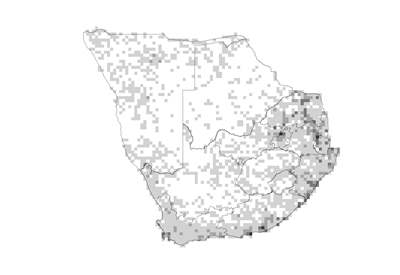 Species distribution and density. Darker squares represent higher density of members of this family. |
Introduction
Euphorbia family
A very large and diverse family that has recently been divided into a number of different families. In this contribution it is treated in a very broad and liberal sense to include the Phyllanthaceae, Picrodendraceae and Putranjivaceae.
Distribution
Cosmopolitan, mainly in tropics, but excluded from Antarctica. Southern Africa has higher levels of diversity along the south and east coast from Port Elizabeth to Durban and on the Mpumalanga escarpment to the Soutpansberg.
Number of genera in the world
ca. 250-300
Number of species in the world
ca. 5 000-6 300
Number of genera in the Flora of southern Africa region
54
Number of species in the Flora of southern Africa region
537
Well-known southern African genera
Acalypha, Bridelia, Clutia, Croton, Dalechampia, Euphorbia, Jatropha, Monadenium, Phyllanthus, Sapium, Spirostachys, Tragia
Growth forms
Trees, shrubs, herbs, climbers or twiners and succulents. South African members mostly succulent.
Habitats
Found in a wide variety of habitats, e.g. scrub, woodland and forest, grassland, arid regions and desert.
Flagship species
Euphorbia ingens (common tree euphorbia; gewone naboom [A]; mokgoto [NS]) grows into a tree of 15 m high and is characteristic of wooded areas in the northern regions of southern Africa. The soft wood is used for light wooden doors, planks and even canoes. The milky latex is toxic and caustic, but if applied correctly can be used medicinally as a purgative or for the treatment of ulcers. The seed is used as a fish poison. It is an excellent focus plant that attracts many insects and birds to the garden. (Photo: GN).
Significance of the family
Many species, especially the succulents, are cultivated as garden plants and ornamentals. Numerous species that originate from the temperate regions have become invasive. The tuberous roots of cassava (*Manihot esculenta), is one of the major sources of food (starch) in tropical regions. *Hevea brasiliensis is a source of rubber and is widely cultivated. Oil is extracted from the seeds of many species in this family, e.g. castor oil (*Ricinus communis).
Diagnostic characters
Herbaceous, woody, occasionally succulents with fleshy stems . Plants often with watery or milky sap . Leaves alternate with bracts . Flowers unisexual, regular ; inflorescence sometimes a cyathium . Calyx 5; corolla mostly or sometimes absent. Ovary superior, mostly 3-locular with 3-lobed style �. Fruit mostly a dry capsule , seed sometimes with fleshy caruncle �. Many species with glands where the lamina and petiole meet (e.g. Spirostachys, Croton) �. (Photo : GN).
Did you know?
Cassava is a major staple food in the developing world providing a basic diet for about 500 million people.